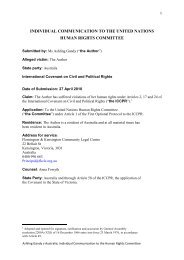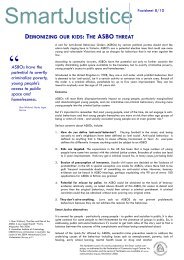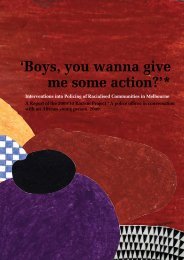Lacking Insight - Community Law
Lacking Insight - Community Law
Lacking Insight - Community Law
- No tags were found...
Create successful ePaper yourself
Turn your PDF publications into a flip-book with our unique Google optimized e-Paper software.
Part 1 > SummaryMethodology and research toolsThe project is a qualitative study using an actionresearch model where data collection and evaluationproceed simultaneously. This model enables broadscoping of the major issues as they arise andcaptures a range of experiences in depth, allowingparticipants to ‘tell their story’ from their individualviewpoint. It provides the opportunity to re-evaluateand make adjustments in the focus of the projectas the data is evaluated in a series of feedbackloops (Punch 1998). Interview and discussiongroup prompts were revised and modified in lightof ongoing data analysis as a part of the project’sinteractive process.Project guidanceA Steering Group of key stakeholders wasestablished (see appendix); it included an AdvisoryGroup of four people with experience of involuntarystatus, with experience of mental illness or allegedmental illness and with the capacity to representthose who have been involuntary patients. This groupof four people met separately with the researchersand assisted with networking among consumers andwith the development of the interview schedule.EthicsEthics approval for the research project wasgranted by the Human Research Ethics Committeefrom Department of Human Services (‘DHS’). Allparticipants have been de-identified during thetranscription process and tapes destroyed.Sampling DesignThe project used a snowball technique to identifyinterested participants. This involved makingcontact with relevant people or bodies involved withconsumers who had appeared before the Boardas involuntary patients. Consumers interested inparticipating were targeted by promotional material,widely distributed through consumer networks andarea mental health services. Participants for discussiongroups were recruited from a variety of sources toavoid situations where they may have discussed theissues together previously. Care was taken whereverpossible, to prompt involvement of people who werenot active mental health consumers and those whomay not have participated actively in a hearing.A purposeful sampling framework was utilised inselecting participants through the application ofminimum sample criteria limits. This sampling designwas broadly indicative of various factors includingcharacteristics of the caseload of the Board. Withinthe budgetary and logistical constraints of the projectno significant source of variance was missed. Theproject aimed to capture a cross section of diversityof people who had an involuntary patient experience,and to include the following characteristics:• Site of treatment−− Inpatient treatment−− <strong>Community</strong> Treatment Orders• Types of psychiatric diagnosis ~ consumers withexperience of:−− Mood disorders−− Psychotic disorders−− Other diagnoses• Type of treatment−− Medication types and methods−− Electro convulsive therapy (ECT)−− Seclusion and restraint−− Additional attributes−− Rural and Metropolitan (Variety of suburbs)−−−−Security PatientsGender19
















